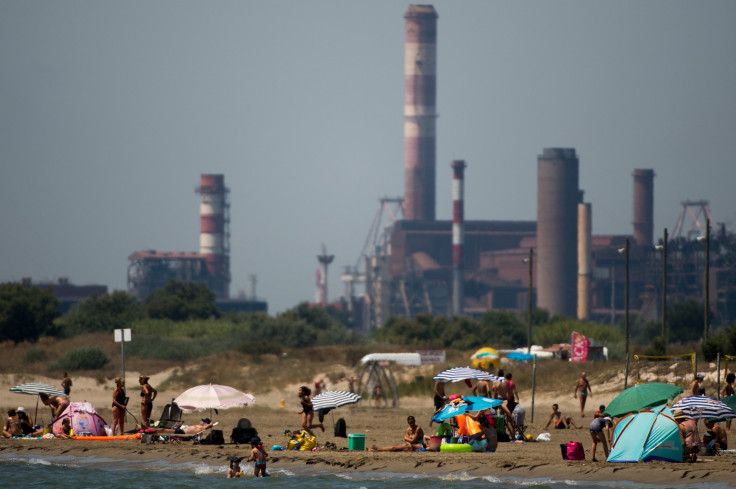Air Pollution Levels May Rise Significantly By 2050, Causing Health Risks

You may recall ozone is the gas that surrounds the Earth’s atmosphere; it makes up the stratosphere, which can extend from 4 to 31 miles above the Earth’s surface, and is typically beneficial for us. The ozone layer is like a protective bubble that protects humans, animals, and plants from damaging ultraviolet rays coming from the sun.
Though ozone — consisting of three oxygen atoms (O3) — is naturally produced in the atmosphere, it can also be a man-made product that floats in the lower atmosphere, at a much closer distance to us. In the cases where ozone reaches the air we breathe, it’s often created by reactions between two different types of air pollutants during intense heat and sunlight, and can contribute to smog and hazy summer days. This type of ozone can mess with our respiratory systems and lead to health issues. Days in which ozone levels are unusually high in the air are considered unhealthy “ozone days,” or “ozone episode days.”
The United States may experience three to nine more days of unhealthy ozone levels each year by 2050 if our air quality continues to remain poor, according to a new study out of Harvard’s John A. Paulson School of Engineering and Applied Sciences (SEAS). The study found that California, the Southwest, and the Northeast would be at highest risk, with each region expected to experience up to nine more days of hazardous ozone levels.
“In the coming decades, global climate change will likely cause more heat waves during the summer, which in turn could cause a 70 to 100 percent increase in ozone episodes, depending on the region,” said Lu Shen, a graduate student at SEAS and first author of the study, in the press release.
For the study, the researchers analyzed existing observations about the link between temperature and ozone levels. In the past, scientists have noticed that increased heat — or global warming — was linked to more dangerous ozone levels. By examining these observations, the researchers of the latest study attempted to predict what would happen in the future if emissions continued to increase.
“Ozone production accelerates at high temperatures, and emissions of the natural components of ozone increase,” said Loretta Mickley, a co-author of the study, in the press release. “High temperatures are also accompanied by weak winds, causing the atmosphere to stagnate. So the air just cooks and ozone levels can build up.”
The researchers also focused on a phenomenon known as ozone suppression, in which ozone levels stop rising at very high temperatures, typically in the 90s. In the past, ozone suppression had only been observed in California (which is notorious for having high levels of air pollution), so they wanted to see if it occurred anywhere else, and whether it is caused by chemistry or the weather. Their study suggests it is the weather, since it turned out 20 percent of measurement sites in the U.S. experienced ozone suppression at really hot temperatures.
“Typically, ozone is tightly correlated with temperature, which in turn is tightly correlated with other meteorological variables such as solar radiation, circulation, and atmospheric stagnation,” Shen said. “But at extreme temperatures, these relationships break down.”
Last year, the American Lung Association released a report that listed Los Angeles, Porteville, Hanford, Bakersfield, Fresno, and Sacramento (all in California) as the most ozone-polluted cities in the U.S., where it was deemed “dangerous to breathe.” Air pollution has been linked to lung cancer, infertility, heart disease, and increased mortality risk, and the latest study suggests that rates of these diseases may increase if America doesn’t reel in dangerous emissions. On an even bigger scale, climate change has been linked to health risks across the entire world, particularly among children — increasing their risk of asthma, mental health issues, and infections.
Despite the fact that ozone levels are particularly high in southern California, the study also hints that as years go on they can expand to any part of the country — even rural areas. “Ozone formation is not limited to big cities like Los Angeles, Houston, Atlanta, and New York City,” the EPA states on its website. “It is also formed in smaller cities like Raleigh, N.C. and Cincinnati, and it is transported hundreds of miles downwind from where it is created to affect ambient air quality in other urban and rural areas.”
As a result, the researchers concluded that emissions controls should be more vigorous to prevent ozone increases in our future. “This research gives us a much better understanding of how ozone and temperature are related and how that will affect future air quality,” Mickley said. “These results show that we need ambitious emissions controls to offset the potential of more than a week of additional days with unhealthy ozone levels.”
Source: Shen L, Mickley L, Gilleland E, et al. Geophysical Research Letters . 2016.



























